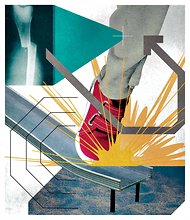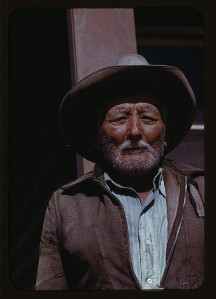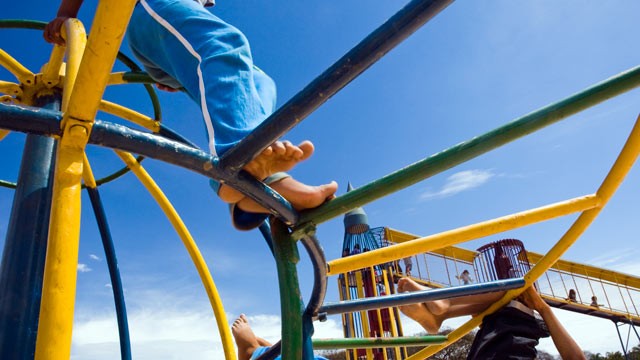The screens that are stealing childhood
I'm not a Luddite, I utilise a blog for goodness sake. However I'm not three years old either. I can make a choice about when to use tech to fulfil my work or leisure purposes. I didn't have tech introduced to me as a recreational pastime nor is my adoption and use of it tacitally encouraged by a peer group. As I've said before, I do recognise that we live in a world that increasingly requires computer literacy as a basic vehicle for material success, however as I have repeatedly blogged* before, the unregulated introduction of tech to children from an early age is creating a false reality and rather than joining them with their communities is further isolating them from the peers that they (with their parents facilitation) are striving to be like. The article is interesting, but I was also intrigued by the comments below the actual article. They are definitely worth a look.
*Getting out of the box
Jury is still out, but iPads may put the pen to the sword
Is iPad an educational tool or a lifestyle addiction?
The Interweb: Font of all knowledge.
Selling U crap you just don't need
BABIES WITH IPADS
iPadding toddlers: When is it too soon?
Excerpts below -the full article can be read from the link above
I'm not a Luddite, I utilise a blog for goodness sake. However I'm not three years old either. I can make a choice about when to use tech to fulfil my work or leisure purposes. I didn't have tech introduced to me as a recreational pastime nor is my adoption and use of it tacitally encouraged by a peer group. As I've said before, I do recognise that we live in a world that increasingly requires computer literacy as a basic vehicle for material success, however as I have repeatedly blogged* before, the unregulated introduction of tech to children from an early age is creating a false reality and rather than joining them with their communities is further isolating them from the peers that they (with their parents facilitation) are striving to be like. The article is interesting, but I was also intrigued by the comments below the actual article. They are definitely worth a look.
*Getting out of the box
Jury is still out, but iPads may put the pen to the sword
Is iPad an educational tool or a lifestyle addiction?
The Interweb: Font of all knowledge.
Selling U crap you just don't need
BABIES WITH IPADS
iPadding toddlers: When is it too soon?
Excerpts below -the full article can be read from the link above
Parents need to be vigilant about the effects of constant stimulation, writes Andrew Stevenson
Take a look around you and, in cars, shopping centres and restaurants, chances are you'll find young children engrossed, not in the world around them, but in their new digital reality.
Australians have smartphones and tablet computers gripped in their sweaty embrace, adopting the new internet-enabled technology as the standard operating platform for their lives, at work, home and play.
But it is not only adults who are on the iWay to permanent connection. As parents readily testify, many children don't just use the devices, they are consumed by them.
''These devices have an almost obsessive pull towards them,'' says Larry Rosen, professor of psychology at California State University and author of iDisorder: Understanding Our Obsession with Technology and Overcoming its Hold on Us.
''How can you expect the world to compete with something like an iPad3 with a high-definition screen, clear video and lots of interactivity? How can anything compete with that? There's certainly no toy that can.
''Even old people like me can't stop themselves from tapping their pocket to make sure their iPhone is there. Imagine a teenager, even a pre-teen, who's grown up with these devices attached at the hip 24/7 and you end up with what I think is a problem.''
The technology has been absorbed so comprehensively that the jury on the potential impact on young people is not just out, it's yet to be empanelled.
''The million-dollar question is whether there are risks in the transfer of real time to online time and the answer is that we just don't know,'' says Andrew Campbell, a child and adolescent psychologist.
.....Parents used to worry only about TV use. Now school students' screen use may begin at home with TV in the morning, continue with interactive whiteboards, laptops and computers in class, smartphones at lunch and on the bus, and continue at home with TV, computer, phone and tablet. Wayne Warburton, a psychologist at Macquarie University, says US studies show that beyond the school gates, teenagers are using screens or listening to music for more than 7½ hours a day. In Australia it is more than five hours and rising.
Authoritative standards on appropriate levels of use are limited. The American Academy of Paediatrics recommends parents discourage TV for children under two and limit screen time for older children to less than two hours a day.
The guidelines, says Professor Rosen, are ''ludicrous'' but the need for them and constant communication with young people about technology and how they use it, remains. ''It's no longer OK to start talking to your kids about technology when they're in their teens. You have to start talking to them about it as soon as you hand them your iPhone or let them watch television or Skype with grandma,'' he says.
He suggests a ratio of screen time to other activities of 1:5 for very young children, 1:1 for pre-teens and 5:1 for teenagers. Parents should have weekly talks with their children from the start, looking for signs of obsession, addiction and lack of attention.
.....''Parents say to me they would love to put some limits on their kids' media use but that it is so much a part of their identity - playing the same games as their friends, being involved with the same media - that they feel they would be losing friends, losing identity and having problems if they didn't have access,'' he says.
Take a look around you and, in cars, shopping centres and restaurants, chances are you'll find young children engrossed, not in the world around them, but in their new digital reality.
Australians have smartphones and tablet computers gripped in their sweaty embrace, adopting the new internet-enabled technology as the standard operating platform for their lives, at work, home and play.
But it is not only adults who are on the iWay to permanent connection. As parents readily testify, many children don't just use the devices, they are consumed by them.
''These devices have an almost obsessive pull towards them,'' says Larry Rosen, professor of psychology at California State University and author of iDisorder: Understanding Our Obsession with Technology and Overcoming its Hold on Us.
''How can you expect the world to compete with something like an iPad3 with a high-definition screen, clear video and lots of interactivity? How can anything compete with that? There's certainly no toy that can.
''Even old people like me can't stop themselves from tapping their pocket to make sure their iPhone is there. Imagine a teenager, even a pre-teen, who's grown up with these devices attached at the hip 24/7 and you end up with what I think is a problem.''
The technology has been absorbed so comprehensively that the jury on the potential impact on young people is not just out, it's yet to be empanelled.
''The million-dollar question is whether there are risks in the transfer of real time to online time and the answer is that we just don't know,'' says Andrew Campbell, a child and adolescent psychologist.
.....Parents used to worry only about TV use. Now school students' screen use may begin at home with TV in the morning, continue with interactive whiteboards, laptops and computers in class, smartphones at lunch and on the bus, and continue at home with TV, computer, phone and tablet. Wayne Warburton, a psychologist at Macquarie University, says US studies show that beyond the school gates, teenagers are using screens or listening to music for more than 7½ hours a day. In Australia it is more than five hours and rising.
Authoritative standards on appropriate levels of use are limited. The American Academy of Paediatrics recommends parents discourage TV for children under two and limit screen time for older children to less than two hours a day.
The guidelines, says Professor Rosen, are ''ludicrous'' but the need for them and constant communication with young people about technology and how they use it, remains. ''It's no longer OK to start talking to your kids about technology when they're in their teens. You have to start talking to them about it as soon as you hand them your iPhone or let them watch television or Skype with grandma,'' he says.
He suggests a ratio of screen time to other activities of 1:5 for very young children, 1:1 for pre-teens and 5:1 for teenagers. Parents should have weekly talks with their children from the start, looking for signs of obsession, addiction and lack of attention.
.....''Parents say to me they would love to put some limits on their kids' media use but that it is so much a part of their identity - playing the same games as their friends, being involved with the same media - that they feel they would be losing friends, losing identity and having problems if they didn't have access,'' he says.



















